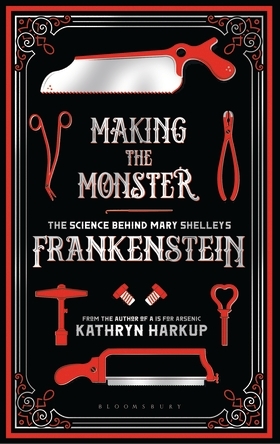 |
Making the Monster
by Kathryn Harkup ISBN-13: 9781472933737 Hardcover: 304 pages Publisher: Bloomsbury USA Released: Feb. 6, 2018 |
Source: ebook review copy from the publisher through NetGalley.
Book Description, Modified from NetGalley:
The year 1818 saw the publication of one of the most influential science-fiction stories of all time. Frankenstein: Or, Modern Prometheus by Mary Shelley had a huge impact on gothic horror and science fiction genres. How did a 19-year-old woman with no formal education come up with the idea for an extraordinary novel such as Frankenstein? The period of 1790–1820 saw huge advances in our understanding of electricity and physiology. Sensational science demonstrations caught the imagination of the general public, and newspapers were full of tales of murderers and resurrectionists.
Kathryn Harkup examines the science and scientists that influenced and inspired Mary Shelley. It is unlikely that Victor Frankenstein would have been successful in his attempts to create life back in 1818, but we can now resuscitate people using defibrillators, save lives using blood transfusions, and prolong life through organ transplants. Many of these modern achievements are a direct result of 19th century scientists conducting their gruesome experiments on the dead.
My Review:
Making the Monster is about the science and people that influenced the making of the story "Frankenstein." The book started with a biography of Mary Shelley's life, focusing on the people and events that probably inspired parts of the novel. It ended with this biography, briefly talking about Mary Shelley's life after "Frankenstein" was published. The author also compared the books (the original and the 1831 revised version) and the books to the various play and movie adaptations of the story.
The middle of the book explored the scientific thought of the time that lead to the character, Victor, thinking (and succeeding) in making life from dead body parts. The author talked about how Victor might have made the monster (as the novel is vague), discussing things like the various ways they had to preserve dead body parts from decaying. The author talked about the Resurrection Men and how human anatomy was studied in the late 1700s and early 1800s. Frankly, the descriptions in this part were gory and gross. She also covered the process of decomposition in a human body after death.
She gave a brief history of surgical methods up to the early 1800s and considered how the various body parts might have been sewn together. She talked about organ transplants and blood transfusions--both what they could do at the time and the challenges we now know Victor would have faced in piecing a monster together. The author also talked about the electricity experiments going on around that time and the idea that electricity might bring a person back to life. She described how the proto-evolutionary ideas at that time influenced the story. Overall, this book was interesting but more gory in the science details than I cared for.
If you've read this book, what do you think about it? I'd be honored if you wrote your own opinion of the book in the comments.
Excerpt: Read an excerpt using Google Preview.




No comments:
Post a Comment